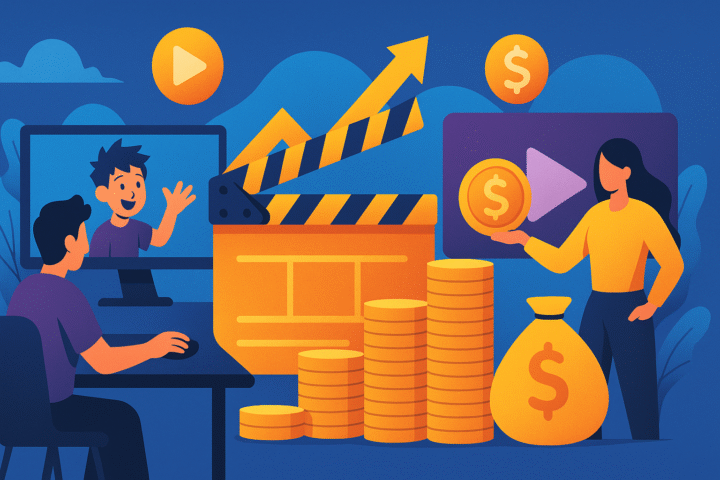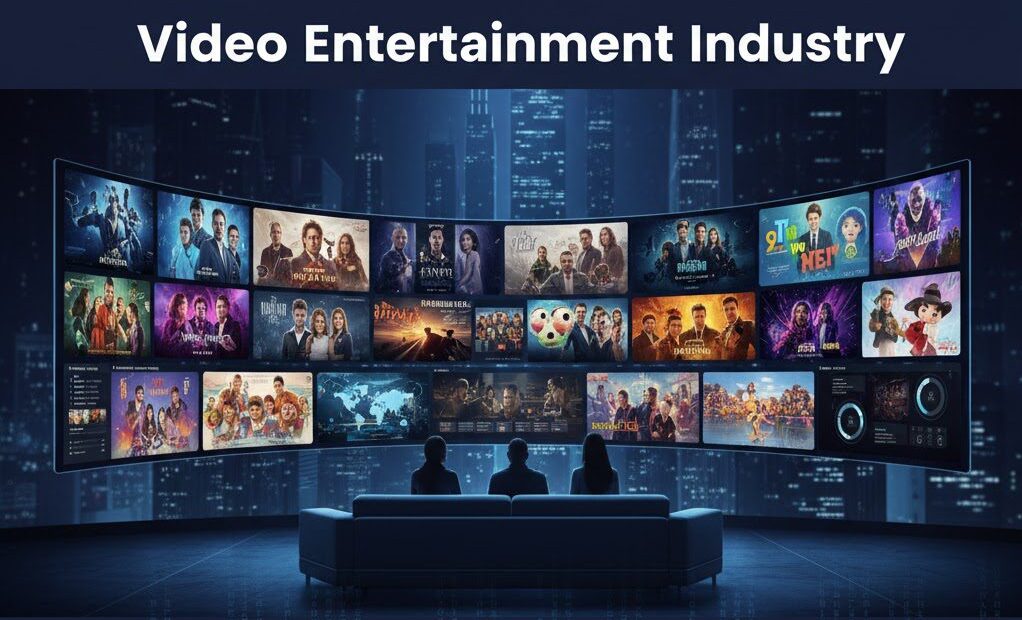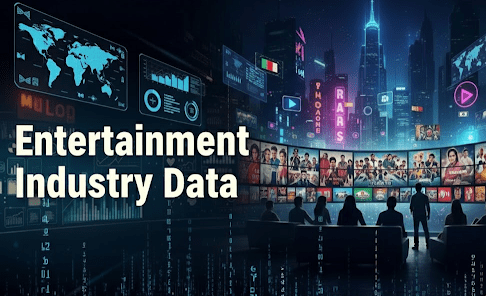Introduction
The animation industry is a realm of boundless creativity, but translating that artistry into sustainable revenue requires forward-thinking animation monetization strategies. For animation company executives and sales strategists, understanding how to maximize the value of animated content in a rapidly evolving global market is paramount. The future isn’t just about traditional licensing models; it’s about leveraging the power of data, the intelligence of Artificial Intelligence (AI) for distribution, and the reach of global marketplaces.
This article explores the evolving landscape of animation industry revenue, highlighting how data-driven animation sales and innovative approaches like AI for animation distribution are shaping new pathways to success. Discover how to prepare your animation business for the next wave of monetization opportunities.
Table of content
- Introduction
- Key-Takeaways
- Traditional Animation Monetization vs. Future-Forward Strategies
- The Power of Data: Fueling Smarter Animation Sales and Valuation
- AI for Animation Distribution: Enhancing Reach and Efficiency
- Global Marketplaces: Expanding Your Animation’s Footprint
- Diversifying Revenue Streams Beyond Core Licensing
- Emerging Technologies: NFTs, Metaverse, and Interactive Animation Monetization
- Preparing Your Animation Studio for Future Monetization
- Conclusion
- FAQs
Key Takeaways
| Monetization Aspect | Future-Forward Insight | |
|---|---|---|
| Evolving Animation Monetization Strategies | Moving beyond traditional sales to embrace data-informed decisions, diverse platform strategies, and new revenue streams. | |
| Data-Driven Animation Sales | Utilizing audience analytics, performance data, and market trends to optimize pricing, targeting, and distribution choices. | |
| AI for Animation Distribution | AI tools enhance content discovery for buyers, help predict demand, and can streamline rights management, boosting sales efficiency. | |
| Global Marketplaces | Platforms like Vitrina provide direct access to international buyers, expanding reach and revenue potential. | |
| Maximizing Value of Animated Content | Involves strategic windowing, exploring ancillary rights (merchandising, gaming), and adapting to new consumption models. | |
| New Revenue Streams | Potential in interactive content, NFTs (for collectibles/engagement), and Metaverse experiences, though still emerging. | |
| Further Learning | For a comprehensive overview, see our Ultimate Guide to Animated Content Licensing. | |
Want to Maximize the Value of Your Animated Content?

Traditional Animation Monetization vs. Future-Forward Strategies

Historically, animation industry revenue was primarily driven by a fairly linear path: theatrical releases (for films), broadcast licenses, home video sales, and perhaps some ancillary merchandising for major hits. While these avenues remain relevant, the future of animation monetization demands a more dynamic and diversified approach. Traditional models often relied on established relationships and less on granular data. Future-forward animation monetization strategies, however, are characterized by agility, a deep understanding of global digital platforms, the strategic use of data analytics, and an openness to innovative technologies and business models. It’s about proactively seeking opportunities rather than passively waiting for them.
Limitations of Solely Traditional Approaches:
- Slower Market Responsiveness: Difficulty in quickly adapting to shifting viewer preferences or new platform opportunities.
- Limited Data Utilization: Decisions often based on past performance or gut instinct rather than real-time market intelligence.
- Less Efficient Global Reach: Relying on traditional distribution networks might miss out on niche international buyers or emerging markets.
- Missed Ancillary Opportunities: Sometimes, the full value of animated content across all potential revenue streams (gaming, interactive, digital collectibles) isn’t fully explored.
Characteristics of Future-Forward Monetization:
- Data-Centric: Utilizing analytics to understand audience behavior, content performance, and market demand to inform data-driven animation sales.
- Platform-Agnostic (Yet Strategic): Exploring opportunities across all relevant platforms (SVOD, AVOD, FAST, social, gaming, Metaverse) with tailored strategies for each.
- Globally Minded: Actively pursuing international licensing and co-production opportunities from the outset.
- Technology-Leveraged: Employing tools like AI for animation distribution and global content marketplaces to enhance efficiency and reach.
- Audience-Focused: Developing content and monetization strategies with a deep understanding of specific target audience segments and their consumption habits.
The shift is towards a more proactive, intelligent, and global approach to realizing the value of animated content.
| Aspect | Traditional Monetization | Future-Forward Monetization |
|---|---|---|
| Decision Making | Relationship-based, historical data. | Data-driven, predictive analytics, real-time insights. |
| Market Reach | Often reliant on established distributors. | Global, direct-to-buyer access via digital platforms. |
| Technology Use | Limited. | Integral (AI, data platforms, global marketplaces). |
The Power of Data: Fueling Smarter Animation Sales and Valuation
In the evolving landscape of animation monetization strategies, data has become an invaluable asset. Moving beyond intuition, data-driven animation sales enable studios and distributors to make more informed decisions, optimize pricing, target the right buyers more effectively, and ultimately increase the animation industry revenue generated from their catalogs. By analyzing viewership patterns, audience preferences, market trends, and performance metrics, rights holders can gain a much clearer understanding of the true value of animated content in various contexts.
Types of Data Influencing Animation Sales:
- Audience Analytics: Who is watching what type of animation, on which platforms, in which territories? What are their engagement levels and completion rates?
- Performance Data of Comparable Titles (“Comps”): How have similar animated series or films performed in terms of viewership, ratings, or licensing fees?
- Market Demand Signals: What types of animated content are buyers (broadcasters, streamers) actively searching for? Which genres or themes are trending? Platforms like Vitrina provide these insights.
- Platform-Specific Data: Understanding the programming needs, audience profile, and typical deal structures of individual streaming services or TV channels.
- Social Listening Data: Gauging public buzz, sentiment, and unmet desires related to animated content.
How Data Shapes Sales and Valuation Strategies:
- Optimized Pricing: Setting more accurate license fees based on demonstrable demand and comparable market values rather than guesswork.
- Targeted Pitching: Identifying and prioritizing buyers whose audience and platform strategy align best with a specific animated property, leading to higher conversion rates.
- Identifying Underserved Niches: Data can reveal gaps in the market for certain types of animation, creating new sales opportunities.
- Informing Content Development: Insights from current market demand can even influence future animation production decisions.
- Justifying Value to Buyers: Using data to demonstrate the potential ROI of licensing your content to a specific platform.
Making data-driven animation sales decisions is no longer a luxury but a competitive necessity.
| Data Application | Benefit for Animation Seller | Example |
|---|---|---|
| Audience Preference Analysis | Tailor content pitches to platforms serving relevant demographics. | Pitching a pre-school educational series to channels with strong viewership in that segment. |
| Market Demand Tracking | Identify which genres/themes are currently sought after by buyers. | Noticing increased buyer searches for “adult sci-fi animation” on a B2B platform. |
| Pricing Based on Comps | Set realistic and competitive license fees. | Using data on recent deals for similar animated shorts to price a new one. |
AI for Animation Distribution: Enhancing Reach and Efficiency
Artificial Intelligence is emerging as a transformative tool in developing smarter animation monetization strategies, particularly in the realm of distribution and sales. AI for animation distribution isn’t about replacing human relationships or creative salesmanship; it’s about augmenting these with powerful capabilities for analysis, prediction, and automation. For animation companies looking to maximize their animation industry revenue, AI can help streamline processes, identify new opportunities, and connect their content with the right global buyers more efficiently than ever before. This marks a significant evolution beyond traditional approaches.
How AI is Revolutionizing Animation Sales & Distribution:
- Intelligent Content Discovery for Buyers (Benefits Sellers): AI algorithms on platforms like Vitrina can analyze buyer preferences and platform needs to proactively match them with relevant animated content from sellers’ catalogs. This means sellers’ content gets seen by more qualified and interested leads.
- Predictive Analytics for Demand Forecasting: AI can analyze market trends, historical data, and even script/visual elements to help predict which territories or platforms might show the strongest demand for a particular animated series or film.
- Automated Metadata Tagging & Enrichment: AI can analyze animation content to automatically generate rich, accurate metadata (genre, themes, keywords, character traits), making it more discoverable in large catalogs and B2B marketplaces.
- Optimizing Rights Management: AI tools can assist in tracking complex licensing agreements, identifying available rights (“avails”) across different territories and windows, and flagging potential conflicts, making it easier to manage and monetize animation catalog assets.
- Personalized Marketing at Scale (Future Potential): AI could help tailor marketing messages about available animated content to specific buyer segments.
Vitrina AI as an Enabler:
Platforms like Vitrina are at the forefront of applying AI for animation distribution. By integrating AI-driven search, recommendation engines, and market intelligence tools (like its Project Tracker), Vitrina helps animation sellers:
- Increase the global visibility of their content.
- Connect with a more targeted and relevant pool of international buyers.
- Gain data-driven insights to inform their sales and pricing strategies.
- Streamline the initial stages of the deal-making process.
This intelligent approach is key to enhancing the value of animated content in a competitive market.
| AI Application in Distribution | Benefit for Animation Sellers | Impact on Monetization |
|---|---|---|
| Intelligent Buyer Matching | Content showcased to most relevant potential licensees. | Higher likelihood of sales, better deal terms. |
| Demand Prediction | Identify high-potential markets and platforms. | Focused sales efforts, optimized territory strategy. |
| Automated Metadata/Tagging | Improved discoverability of content in marketplaces. | More views by potential buyers, easier for buyers to find. |
Ready to Embrace the Future of Animation Sales?

Global Marketplaces: Expanding Your Animation’s Footprint
For animation companies, especially independent studios and those looking to break into new international territories, online global content marketplaces have become vital tools in their animation monetization strategies. These digital platforms serve as a dynamic animation content marketplace for sellers, providing unprecedented access to a worldwide network of buyers, including broadcasters, streaming services, and distributors. Leveraging such a marketplace can significantly amplify an animation studio’s reach, streamline initial sales processes, and help effectively monetize animation catalog assets that might otherwise remain undiscovered. This is a key component of modern data-driven animation sales.
Advantages of Using Global Content Marketplaces:
- Expanded International Reach: Showcase your animated films and series to a curated list of verified buyers from virtually every corner of the globe, far beyond your existing personal networks or the reach of a single sales agent.
- Cost-Effective Marketing & Sales Channel: Reduces the need for extensive and expensive travel to numerous physical content markets. A listing can serve as a 24/7 virtual booth.
- Direct Connection with Buyers: Many platforms facilitate direct communication, allowing you to receive inquiries, pitch your content, and even begin negotiations with interested parties.
- Targeted Visibility: Buyers use specific search criteria, meaning your content is more likely to be discovered by those actively seeking the type of animation you offer.
- Efficient Catalog Management: Centralize your sales materials (trailers, screeners, synopses, rights availability) in one easily accessible place for potential buyers.
- Market Intelligence: Gain insights from platform analytics on buyer interest, trending searches, and regional demand, which can inform your sales strategy and even future production. Vitrina is an example of a platform offering such intelligence.
Making the Most of These Platforms:
To maximize the value of animated content on these marketplaces:
- Create detailed, accurate, and compelling listings for each title.
- Use high-quality visuals (key art, trailers).
- Clearly specify available rights, territories, and windows.
- Be responsive to buyer inquiries.
- Keep your catalog and availabilities updated.
These platforms are powerful tools for an effective AI for animation distribution-enhanced strategy.
| Marketplace Benefit | How it Aids Animation Sellers | Monetization Impact |
|---|---|---|
| Global Buyer Network | Access to previously unreachable international markets. | Increased sales opportunities and licensing revenue. |
| Targeted Discovery | Content is found by buyers with specific needs. | Higher quality leads, better chance of deal conversion. |
| Efficiency | Reduced costs for marketing and initial outreach. | Improved ROI on sales efforts. |
Diversifying Revenue Streams Beyond Core Licensing
While licensing broadcast, SVOD, and theatrical rights forms the core of most animation monetization strategies, truly maximizing the value of animated content often involves looking beyond these primary streams. Successful animated properties, especially those with strong characters and world-building, have immense potential for diversification into various ancillary revenue streams. For animation company executives and sales strategists, exploring these additional avenues can significantly boost overall animation industry revenue and build enduring franchises. This requires a holistic view of your intellectual property (IP).
Key Ancillary Revenue Opportunities for Animation:
- Merchandising and Consumer Products: This is a huge area for popular animation, especially kids’ content. Licensing characters and artwork for toys, apparel, books, stationery, collectibles, food products, etc., can generate substantial income.
- Video Games and Interactive Experiences: Adapting animated IP into mobile, console, or PC games, or creating interactive VR/AR experiences.
- Publishing: Storybooks, comic books, activity books, and graphic novels based on the animated content.
- Live Shows and Events: Stage shows, character meet-and-greets, themed attractions at amusement parks.
- Soundtracks and Music Licensing: Releasing soundtracks or licensing original songs from the animation for other uses.
- Educational Materials: For animation with educational value, licensing for use in schools or educational apps.
- Promotional Tie-ins and Brand Partnerships: Collaborating with other brands for co-marketing initiatives.
Strategic Considerations for Ancillary Rights:
- IP Strength: Not all animated content lends itself equally to merchandising or other ancillaries. Strong, appealing characters and a well-defined world are key.
- Target Audience: The type of ancillary products will depend heavily on the age and interests of the animation’s target audience.
- Rights Management: Ensure your core content production agreements clearly define who controls and benefits from these ancillary rights. Often, these are licensed out separately by specialized merchandising L&M (Licensing & Merchandising) agents.
- Brand Consistency: Maintain quality and consistency across all licensed products and experiences to protect the integrity of your animated IP.
Thinking broadly about how to monetize animation catalog assets includes these valuable extensions.
| Ancillary Revenue Stream | Potential for Animation | Key Success Factor |
|---|---|---|
| Merchandising (Toys, Apparel, etc.) | Very High (especially for Kids’ IP) | Strong character appeal, brand recognition. |
| Video Games / Interactive | High (for action, adventure, character-driven IP) | Engaging gameplay, faithful adaptation of IP. |
| Publishing (Books, Comics) | Moderate to High | Strong storytelling, appealing visuals. |
Emerging Technologies: NFTs, Metaverse, and Interactive Animation Monetization
The cutting edge of animation monetization strategies involves exploring how emerging technologies like Non-Fungible Tokens (NFTs), the Metaverse, and interactive storytelling can create new forms of value and engagement. While many of these areas are still nascent and experimental, they offer intriguing possibilities for the future of animation industry revenue and how audiences interact with animated IP. Forward-thinking animation companies are beginning to dip their toes into these waters, looking for innovative ways to leverage the unique strengths of animation in these new digital realms. This is where AI for animation distribution might also play a role in managing new types of digital assets.
NFTs and Digital Collectibles for Animation:
NFTs have gained attention as a way to create verifiable digital scarcity and ownership. For animation, this could mean:
- Limited Edition Digital Art/Clips: Selling NFTs of unique character art, iconic scenes, concept sketches, or short animated loops as digital collectibles for fans.
- Access Tokens: NFTs granting holders exclusive access to special content, behind-the-scenes material, online communities, or early releases.
- Potential for Royalty Mechanisms (complex): Some NFT platforms explore built-in resale royalty mechanisms, though this is still evolving.
The primary focus currently is on collectibles and fan engagement rather than core content licensing.
Animation in the Metaverse:
The concept of persistent, shared virtual worlds (the Metaverse) opens up possibilities like:
- Virtual Premieres and Screenings: Hosting animated film or series premieres in virtual cinemas or event spaces.
- Branded Experiences: Creating immersive worlds or experiences based on animated IP within Metaverse platforms.
- Virtual Merchandise (Avatars, Items): Licensing animated characters or assets for use as avatars or virtual goods within these worlds.
- Interactive Storytelling: Developing new forms of animated narratives that users can interact with inside a Metaverse environment.
Monetization models for Metaverse content are still largely undefined but hold future potential.
Interactive Animation:
Beyond traditional linear storytelling, interactive animation allows viewers to make choices that influence the plot.
- Choose-Your-Own-Adventure Style: Platforms might license interactive animated specials or series where audience input directs the narrative.
- Gamified Animation: Blurring the lines between passive viewing and active gameplay.
This requires different production workflows and licensing considerations regarding the branching narratives and multiple outcomes.
| Emerging Technology | Potential Animation Monetization Use Case | Current Stage |
|---|---|---|
| NFTs | Digital collectibles, fan engagement, access tokens. | Experimental, primarily focused on collectibles. |
| Metaverse | Virtual events, branded experiences, virtual goods. | Early development, models still forming. |
| Interactive Animation | Premium VOD, specialized platform content. | Niche but growing, requires specific platform capabilities. |
Preparing Your Animation Studio for Future Monetization
To thrive in the evolving landscape of animation monetization strategies, studios and creators need to be proactive and adaptable. This means not only producing high-quality, engaging animation but also building a business that is ready to capitalize on new opportunities presented by data, AI, global marketplaces, and emerging technologies. Future-proofing your studio involves a strategic focus on rights management, technological literacy, market awareness, and building a global mindset. This preparation will maximize the long-term value of animated content you create.
Key Steps for Future Readiness:
- Robust Rights Management from Day One: Ensure all contracts (with writers, artists, musicians, voice talent) are clear about ownership and the ability to exploit rights across all current and future platforms and territories. Maintain meticulous records.
- Invest in Data Literacy: Develop skills within your team (or partner with experts) to understand and utilize audience data, market trends, and performance analytics to inform both production and sales decisions for data-driven animation sales.
- Embrace Digital Sales Channels: Actively utilize online B2B content marketplaces like Vitrina to expand global reach and connect with a diverse range of international buyers.
- Explore AI Tools: Stay informed about how AI for animation distribution and production can enhance efficiency, discovery, and even creative processes.
- Build a Global Network: Cultivate relationships with international distributors, co-producers, platforms, and service providers.
- Stay Flexible and Experimental: Be open to new licensing models, platform opportunities (like AVOD/FAST), and even emerging tech like NFTs or Metaverse applications where appropriate for your IP.
- Focus on High-Quality, Translatable IP: Create stories and characters with universal appeal that can resonate across cultures, facilitating easier international licensing and localization.
Conclusion
The future of animation monetization is bright and full of potential, but it demands a strategic, informed, and adaptable approach from animation companies, executives, and sales strategists. By embracing data-driven animation sales, leveraging the efficiencies of AI for animation distribution, tapping into the global reach of online marketplaces like Vitrina, and exploring diverse revenue streams beyond traditional licensing, studios can significantly enhance the value of animated content and boost their overall animation industry revenue. The key is to be forward-thinking, globally minded, and always focused on creating high-quality animation that resonates with audiences worldwide.
As new technologies and platforms continue to emerge, the landscape will keep evolving. Those who are prepared to learn, experiment, and strategically manage their intellectual property will be best positioned to thrive. For a broader understanding of the entire licensing ecosystem, please refer to our Ultimate Guide to Animated Content Licensing.
Ready to unlock the full financial potential of your animation? Explore Vitrina to discover data-driven insights, connect with global buyers, and implement cutting-edge animation monetization strategies.
Frequently Asked Questions
Small studios can compete by focusing on unique, high-quality niche content, being agile, effectively using online marketplaces to gain global visibility, and by being flexible in their deal-making. Strong storytelling and a distinct artistic voice are key differentiators. Exploring co-productions can also help.
Both strategies can work. A large library can generate consistent revenue from AVOD/FAST and non-exclusive deals. A few high-value IPs can yield significant returns from premium licensing, merchandising, and franchise building. Many studios aim for a mix. The key is understanding the value of animated content in different contexts.
Some text
Currently, NFTs are more of an experimental or supplementary revenue stream focused on digital collectibles and fan engagement for animation projects with existing strong fanbases. They are not yet a primary or reliable monetization strategy for the core licensing of most animated content itself.


















































![Mumbai's Top VFX Studios [2025 Ranking] 44 Mumbai's Top VFX Studios](https://vitrina.ai/wp-content/uploads/2025/10/Mumbais-Top-VFX-Studios-e1761547005725.jpg)








